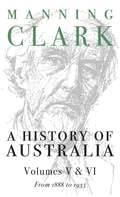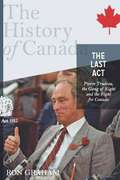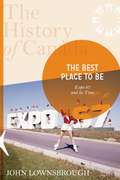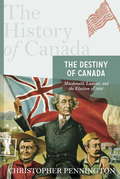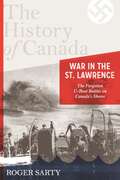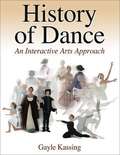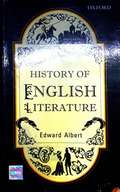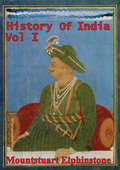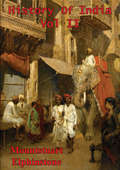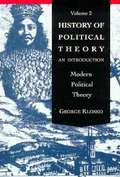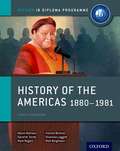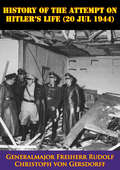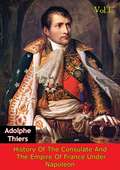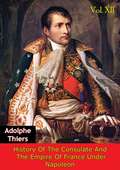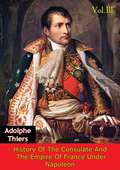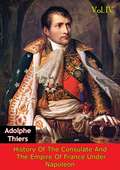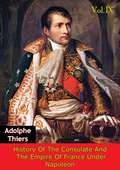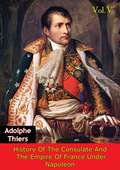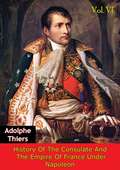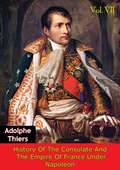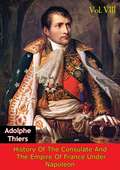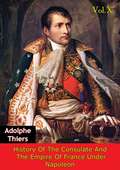- Table View
- List View
History Of Australia (Volumes 5 & 6): From 1888 to 1945
by Manning ClarkManning Clark's six-volume history is one of the masterpieces of Australian writing. It is also one of the most passionately debated visions of Australian history, in which the struggle to realise an Australian nation is played out on an epic scale. A History of Australia: 1888-1945, covers Federation, the Boer War and World War I's Gallipoli. It finishes with the story of an emerging Australian identity at the point of its greatest trial-the outbreak of World War II. This is not a general Australian history-it does not attempt to cover all aspects-and it is not a definitive or quantitative analysis. It is a work of art, a living and breathing account of the remaking of a primitive continent, history come alive.
History Of Canada Series-the Last Act:pierre Trudeau,The
by Ron GrahamBetween the morning of Wednesday, November 4, and the morning of Thursday, November 5, 1981, a fateful drama unfolded that changed Canada forever. In one last attempt to renew the constitution with the consent of the provinces, Prime Minister Pierre Elliott Trudeau met behind closed doors in Ottawa with the ten premiers. It was the culmination of more than five decades of constitutional wrangling, and has been called the most important conference since the Fathers of Confederation got together in Quebec City in 1864. Faced with the threat of Quebec independence, the ambitions of Western Canada, and the provinces' demands for more power, Trudeau was embattled. But he was fiercely determined to make Canadians fully independent and to entrench a Charter of Rights and Freedoms. What happened that day still reverberates. It severed the last important link to Canada's colonial past. It guaranteed individual liberty and minority rights in the future. It weakened the grip of the elites and gave ownership of the constitution to Canadians. But it came at a price. Quebec alone refused to sign the final deal. René Lévesque, its separatist premier, claimed he had been betrayed by his allies in the Gang of Eight. The legend of the "Night of the Long Knives" took hold, precipitating a series of events that came close to destroying the country. Thirty years later, author Ron Graham delivers a gripping account of the fractious debates and secret negotiations. He uses newly uncovered documents and the candid recollections of many of the key participants to create a vivid record of that momentous twenty-four hours. Authoritative and engaging, The Last Act is a remarkable combination of scholarly research and historical narrative.
History Of Canada Series: The Best Place To Be,The
by John LownsbroughA pivotal event in Canada's history For six months in 1967, from late April until the end of October, Canada and its world's fair, Expo 67, became the focus of national and international attention in a way the country and its people had rarely experienced. Expo 67 crystallized the buoyant mood and newfound sense of confidence many felt during Canada's centennial. It becomes clearer, though, as its forty-fifth anniversary approaches in spring 2012, that Expo was something more than just a great world's fair. For many Canadians, it became a touchstone, a popular event that penetrated the collective psyche. The Best Place to Be takes a look at Expo and at the social and political contexts in which it occurred. It is above all a story of people: the young men and women who worked at Expo, the visitors, and the cameo appearances from the titled and celebrated, such as Elizabeth II, President Lyndon Johnson, President Charles de Gaulle (whose visit to Expo and Montreal became infamous), U.S. Senator Robert F. Kennedy, Jacqueline Kennedy, Princess Grace of Monaco, Princess Margaret, Marshall McLuhan, Sidney Poitier, Laurence Olivier, Cary Grant, Twiggy, and Pierre Trudeau.
History Of Canada Series: The Destiny Of Canada,The
by Christopher PenningtonIt was Sir John A. Macdonald's last campaign. His Conservatives had dominated Canadian politics since Confederation. Their National Policy, which protected Canadian manufacturers from foreign competition, was well established and affection for the "Old Man" was deep and widespread. The Liberal leader, Wilfrid Laurier, was new in the job and uncertain that a Roman Catholic from Quebec had any chance of winning votes outside his home province. But Macdonald's decision to hang Louis Riel had split the country, the economy was in the doldrums, and a movement in support of free trade with the United States gave the Liberals hope. In this richly textured narrative, Christopher Pennington spins a colourful tale of a country poised to make a momentous choice and of nineteenth century politics both at its most principled and at its most corrupt.
History Of Canada Series:war In The St. Lawrence,The
by Roger SartyFrom 1942 to 1944, 15 German submarines destroyed or severely damaged 27 ships, including three Canadian warships, a U.S. Army troop transport, and the Newfoundland ferry Caribou. More than 250 lives were lost. It was the only battle of the twentieth century to take place within Canada's boundaries, and the only battle to be fought almost exclusively by Canadian forces under Canadian, rather than alliance, high command. And for more than 40 years the battle was characterized as a Canadian defeat. But was it a defeat? Drawing on new material from wartime records--including ultra-top-secret Allied decryptions of German naval radio communications, Roger Sarty shows that Canada mounted a successful defence with far fewer resources and in the face of much greater challenges than previously known. He draws vivid pictures of the intense combat on Canada's shores and the interplay of the St Lawrence battle with war politics in Ottawa, Washington and London. At the same time, he weaves a second story: how researchers reassembled the scattered war records in Canada, Britain, the United States and Germany and brought the long-forgotten battle to life for new generations of Canadians and international audiences.
History Of Dance: An Interactive Arts Approach
by Gayle KassingHistory of Dance: An Interactive Arts Approach provides an in-depth look at dance from the dawn of time through the 20th century. Using an investigative approach, this book presents the who, what, when, where, why, and how of dance history in relation to other arts and to historical, political, and social events. In so doing, this text provides a number of ways to create, perceive, and respond to the history of dance through integrated arts and technology. This study of dancers, dances, and dance works within an interactive arts, culture, and technology environment is supported by the National Standards in dance, arts education, social studies, and technology education. History of Dance: An Interactive Arts Approach has four parts. Part I explains the tools used to capture dance from the past. Part II begins a chronological study of dance, beginning with its origins and moving through ancient civilizations and the Middle Ages through the Renaissance. Part III covers dance from the 17th to the 20th century, including dance at court, dance from court to theater, romantic to classical ballet, and dance in the United States. Part IV focuses on 20th-century American dance, highlighting influences on American ballet and modern dance as it emerged, matured, and evolved during that century.
History Of English Literature
by Edward AlbertThe fifth edition of Edward Albert’s History of English Literature, first published in 1979, offers its readers a detailed view of how English literature has evolved through the centuries. Starting from the Old English period to the literature of mid-twentieth century, the book takes a look at how English literature has developed across each period. It talks about the major literary genres of each age, like poetry, prose and drama, their major proponents and offers an extensive list of the notable works published during that period. Special focus has been given to Chaucer, Shakespeare, Milton, Pope and Dryden, whose writings strongly influenced the literary output of their time. Each chapter also contains quotes, together with translations wherever needed, from the many works cited in the text. The book also comes with a broad list of writings under ‘Suggestions for Further Reading’ to guide readers who want to further explore the subject.
History Of India Vol. I (History Of India #1)
by Mountstuart Elphinstone"Appointed through family influence to the East India Company, Mountstuart Elphinstone (1779-1859) arrived on the subcontinent in 1796, quickly learning Persian and developing an interest in Indian civilisation. After postings in Benares, Afghanistan and Poona, he became governor in 1819 of the recently acquired territory that became known as the Bombay Presidency, where he remained until his resignation in 1827. On his return to England, he devoted much of his time to writing and was a founder member of the Royal Geographical Society. This two-volume history, based on a range of Indian sources and first published in 1841, is infused with his lifelong understanding of Indian culture, science and philosophy. A scholarly refutation of James Mill's History, it was the most popular work of its kind among the early Victorian public. Volume 1 takes the history of the subcontinent up to the thirteenth century, while Volume 2 continues to the demise of the Mogul empire in the mid-eighteenth century."- Cambridge Library Collection
History Of India Vol. II (History Of India #2)
by Mountstuart Elphinstone"Appointed through family influence to the East India Company, Mountstuart Elphinstone (1779-1859) arrived on the subcontinent in 1796, quickly learning Persian and developing an interest in Indian civilisation. After postings in Benares, Afghanistan and Poona, he became governor in 1819 of the recently acquired territory that became known as the Bombay Presidency, where he remained until his resignation in 1827. On his return to England, he devoted much of his time to writing and was a founder member of the Royal Geographical Society. This two-volume history, based on a range of Indian sources and first published in 1841, is infused with his lifelong understanding of Indian culture, science and philosophy. A scholarly refutation of James Mill's History, it was the most popular work of its kind among the early Victorian public. Volume 1 takes the history of the subcontinent up to the thirteenth century, while Volume 2 continues to the demise of the Mogul empire in the mid-eighteenth century."- Cambridge Library Collection
History Of Political Theory An Introduction: Volume 2 Modern Political Theory
by George KloskoThe second volume of HISTORY OF POLITICAL THEORY provides an in-depth introduction to a select group of political thinkers. Professor Klosko weaves together excerpted materials with insightful commentary to create this thematically unified look at the central theoretical arguments of liberal political theory.
History Of The Americas, 1880-1981: IB History Course Book (Oxford IB Diploma Program )
by David Smith Yvonne Berliner Alexis Mamaux Mark Rogers Matt Borgmann Shannon Leggett<P>Drive critical, engaged, high level learning and skills. Developed with the IB, this Course Book equips learners to analyze and articulate complex historical concepts and contexts, strengthening performance and potential. Enabling advanced understanding, the student-centred approach actively builds, refines and perfects higher level skills. <P>- Cover the new syllabus in the right level of depth, with rich, thorough subject content from across the Americas for topics 10-17 for Paper 3 <P>- Developed directly the with IB for the new syllabus first examined 2017 <P>- Truly engage learners with topical, relevant material that convincingly connects learning with the modern, global world <P>- Streamline your planning, with a clear and thorough structure helping you logically progress through the syllabus <P>- Build the advanced-level skills learners need for Paper 3, with the student-led approach driving active skills development and strengthening exam performance <P>- Integrate Approaches to learning with ATLs like thinking, communication, research and social skills built directly into learning <P>- Help learners think critically about improving performance with extensive examiner insight and samples based on the latest exam format
History Of The Attempt On Hitler’s Life (20 Jul #1944)
by Generalmajor Freiherr Rudolf Christoph von GersdorffA short but gripping account of the personal experiences of German Army Officer Freiherr Rudolf Christoph von Gersdorff, one of the conspirators against Adolf Hitler. He was deeply involved in the German opposition to the Nazi Party, and carried out an unsuccessful bomb attempt on Hitler's life in 1943.
History Of The Consulate And The Empire Of France Under Napoleon Vol. I [Illustrated Edition] (History Of The Consulate And The Empire Of France Under Napoleon #1)
by Marie Joseph Louis Adolphe Thiers D. Forbes CampbellThe product of twenty years of laborious hard work, this is the definitive work on Napoleon and his times at the helm of the French Nation, written by no less than the first President of the Third Republic.Thiers moved in the highest circles of society and met with many of the surviving generals and statesmen of France and her opponents and wove their recollections into this monumental history. Filled with a particularly Gallic flavour without going into hero-worship, this multi-volume history has stood the test of time.This first volume begins with Napoleon’s 1797 campaign to his ascent to the consulate in 1800.Includes the Napoleonic Wars Map Pack with over 155 maps and plans following the military career of Napoleon.
History Of The Consulate And The Empire Of France Under Napoleon Vol. I [Illustrated Edition] (History Of The Consulate And The Empire Of France Under Napoleon #12)
by Marie Joseph Louis Adolphe Thiers D. Forbes CampbellThe product of twenty years of laborious hard work, this is the definitive work on Napoleon and his times at the helm of the French Nation, written by no less than the first President of the Third Republic.<P><P> Thiers moved in the highest circles of society and met with many of the surviving generals and statesmen of France and her opponents and wove their recollections into this monumental history. Filled with a particularly Gallic flavour without going into hero-worship, this multi-volume history has stood the test of time.<P> This first volume begins with Napoleon’s 1797 campaign to his ascent to the consulate in 1800.<P> Includes the Napoleonic Wars Map Pack with over 155 maps and plans following the military career of Napoleon.
History Of The Consulate And The Empire Of France Under Napoleon Vol. II [Illustrated Edition] (History Of The Consulate And The Empire Of France Under Napoleon #2)
by Marie Joseph Louis Adolphe Thiers D. Forbes CampbellThe product of twenty years of laborious hard work, this is the definitive work on Napoleon and his times at the helm of the French Nation, written by no less than the first President of the Third Republic.<P><P> Thiers moved in the highest circles of society and met with many of the surviving generals and statesmen of France and her opponents and wove their recollections into this monumental history. Filled with a particularly Gallic flavour without going into hero-worship, this multi-volume history has stood the test of time.<P> This second volume details the brief period of peace as the contending opponents rebuild their armies and the Peace of Amiens is finally ruptured in 1803.<P> Includes the Napoleonic Wars Map Pack with over 155 maps and plans following the military career of Napoleon.<P>
History Of The Consulate And The Empire Of France Under Napoleon Vol. III [Illustrated Edition] (History Of The Consulate And The Empire Of France Under Napoleon #3)
by Marie Joseph Louis Adolphe Thiers D. Forbes CampbellThe product of twenty years of laborious hard work, this is the definitive work on Napoleon and his times at the helm of the French Nation, written by no less than the first President of the Third Republic.<P><P> Thiers moved in the highest circles of society and met with many of the surviving generals and statesmen of France and her opponents and wove their recollections into this monumental history. Filled with a particularly Gallic flavour without going into hero-worship, this multi-volume history has stood the test of time.<P> This third volume recounts the forging of Napoleon’s finest instrument the Grande Armée of 1805 and their stupendous Ulm campaign, yet the French navy was shattered at Trafalgar.<P> Includes the Napoleonic Wars Map Pack with over 155 maps and plans following the military career of Napoleon.
History Of The Consulate And The Empire Of France Under Napoleon Vol. IV [Illustrated Edition] (History Of The Consulate And The Empire Of France Under Napoleon #4)
by Marie Joseph Louis Adolphe Thiers D. Forbes CampbellThe product of twenty years of laborious hard work, this is the definitive work on Napoleon and his times at the helm of the French Nation, written by no less than the first President of the Third Republic.<P><P> Thiers moved in the highest circles of society and met with many of the surviving generals and statesmen of France and her opponents and wove their recollections into this monumental history. Filled with a particularly Gallic flavour without going into hero-worship, this multi-volume history has stood the test of time.<P> Napoleon’s power reaches its zenith in the fourth volume with the crushing of Austria at Austerlitz in 1805, Prussia at Jena in 1806 and Russia at Friedland in 1807.<P> Includes the Napoleonic Wars Map Pack with over 155 maps and plans following the military career of Napoleon.
History Of The Consulate And The Empire Of France Under Napoleon Vol. IX [Illustrated Edition] (History Of The Consulate And The Empire Of France Under Napoleon #9)
by Marie Joseph Louis Adolphe Thiers D. Forbes CampbellThe product of twenty years of laborious hard work, this is the definitive work on Napoleon and his times at the helm of the French Nation, written by no less than the first President of the Third Republic.<P><P> Thiers moved in the highest circles of society and met with many of the surviving generals and statesmen of France and her opponents and wove their recollections into this monumental history. Filled with a particularly Gallic flavour without going into hero-worship, this multi-volume history has stood the test of time.<P> Volume Nine chronicles the 1813 campaign in Germany as Napoleon is finally decisively beaten in the field at the battle of Leipzig.<P> Includes the Napoleonic Wars Map Pack with over 155 maps and plans following the military career of Napoleon.<P>
History Of The Consulate And The Empire Of France Under Napoleon Vol. V [Illustrated Edition] (History Of The Consulate And The Empire Of France Under Napoleon #5)
by Marie Joseph Louis Adolphe Thiers D. Forbes CampbellThe product of twenty years of laborious hard work, this is the definitive work on Napoleon and his times at the helm of the French Nation, written by no less than the first President of the Third Republic.<P><P> Thiers moved in the highest circles of society and met with many of the surviving generals and statesmen of France and her opponents and wove their recollections into this monumental history. Filled with a particularly Gallic flavour without going into hero-worship, this multi-volume history has stood the test of time.<P> In this fifth volume Napoleon determines to crush the last of the Bourbons, those of Spain, and becoming entangled in the ‘Spanish Ulcer’.<P> Includes the Napoleonic Wars Map Pack with over 155 maps and plans following the military career of Napoleon.
History Of The Consulate And The Empire Of France Under Napoleon Vol. VI [Illustrated Edition] (History Of The Consulate And The Empire Of France Under Napoleon #6)
by Marie Joseph Louis Adolphe Thiers D. Forbes CampbellThe product of twenty years of laborious hard work, this is the definitive work on Napoleon and his times at the helm of the French Nation, written by no less than the first President of the Third Republic.<P><P> Thiers moved in the highest circles of society and met with many of the surviving generals and statesmen of France and her opponents and wove their recollections into this monumental history. Filled with a particularly Gallic flavour without going into hero-worship, this multi-volume history has stood the test of time.<P> In this sixth volume Napoleon struggles to fight on two fronts with his armies stuck in attritional struggles in Spain and Austria attempting to reconquer their lost territory in 1809.<P> Includes the Napoleonic Wars Map Pack with over 155 maps and plans following the military career of Napoleon.
History Of The Consulate And The Empire Of France Under Napoleon Vol. VII [Illustrated Edition] (History Of The Consulate And The Empire Of France Under Napoleon #7)
by Marie Joseph Louis Adolphe Thiers D. Forbes CampbellThe product of twenty years of laborious hard work, this is the definitive work on Napoleon and his times at the helm of the French Nation, written by no less than the first President of the Third Republic.<P><P> Thiers moved in the highest circles of society and met with many of the surviving generals and statesmen of France and her opponents and wove their recollections into this monumental history. Filled with a particularly Gallic flavour without going into hero-worship, this multi-volume history has stood the test of time.<P> In this seventh volume Britain becomes more involved in the Peninsular War, Napoleon determines to finally come to terms with his erstwhile ally Russia.<P> Includes the Napoleonic Wars Map Pack with over 155 maps and plans following the military career of Napoleon.
History Of The Consulate And The Empire Of France Under Napoleon Vol. VIII [Illustrated Edition] (History Of The Consulate And The Empire Of France Under Napoleon #8)
by Marie Joseph Louis Adolphe Thiers D. Forbes CampbellThe product of twenty years of laborious hard work, this is the definitive work on Napoleon and his times at the helm of the French Nation, written by no less than the first President of the Third Republic.<P><P> Thiers moved in the highest circles of society and met with many of the surviving generals and statesmen of France and her opponents and wove their recollections into this monumental history. Filled with a particularly Gallic flavour without going into hero-worship, this multi-volume history has stood the test of time.<P> Volume Eight chronicles the disastrous 1812 campaign in Russia and the retreat that wrecked the Grande Armée.<P> Includes the Napoleonic Wars Map Pack with over 155 maps and plans following the military career of Napoleon.
History Of The Consulate And The Empire Of France Under Napoleon Vol. X [Illustrated Edition] (History Of The Consulate And The Empire Of France Under Napoleon #10)
by Marie Joseph Louis Adolphe Thiers D. Forbes CampbellThe product of twenty years of laborious hard work, this is the definitive work on Napoleon and his times at the helm of the French Nation, written by no less than the first President of the Third Republic.<P><P> Thiers moved in the highest circles of society and met with many of the surviving generals and statesmen of France and her opponents and wove their recollections into this monumental history. Filled with a particularly Gallic flavour without going into hero-worship, this multi-volume history has stood the test of time.<P> Volume Ten sees Napoleon finally forced from the throne of France in 1814 and thrown sent into exile on the island of Elba.<P> Includes the Napoleonic Wars Map Pack with over 155 maps and plans following the military career of Napoleon.
